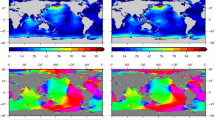Abstract
The model values of the mantle quality factor Q=40±20 and the Chandler wobble period T=435–436 days are obtained by numerical modeling of the yearly and Chandler components in the pole motion from data on the angular momenta of the atmosphere and the ocean. The oceanic and the atmospheric excitations account for about 65–70% of the dispersion of the observed pole motion.
Similar content being viewed by others
References
R. T. Barnes, H. R. Hide, A. A. White, and C. A. Wilson, “Atmospheric Angular Momentum Fluctuations, Length-of-Day Changes and Polar Motion,” Proc. R. Soc. London, Ser. A 387, 31–73 (1983).
R. S. Gross, “Atmospheric and Oceanic Excitation of Length-of-Day Variations during 1980–2000,” J. Geophys. Res. (2003) in press.
R. S. Gross, I. Fukumori, and D. Menemenlis, “Atmospheric and Oceanic Excitation of the Earth’s Wobbles during 1980–2000,” J. Geophys. Res. 108(B8), 2370 (2003).
E. Kalnay, “The NCEP/NCAR 40-Year Reanalysis Project,” Bull. Am. Meteorol. Soc. 77, 437–471 (1996).
S. M. Molodensky and V. N. Zharkov, “On the Chandler Wobble and the Frequency Dependence of the Mantle Q m,” Izv. Akad. Nauk, Fiz. Zemli, No. 4, 3–16 (1981).
D. A. Salstein, D. M. Kann, A. J. Miller, and R. D. Rosen, “The Sub-Bureau for Atmospheric Angular Momentum of the International Earth Rotation Service (IERS): A Meteorological Data Center with Geodetic Applications,” Bull. Am. Meteorol. Soc. 74(1) (1993).
D. A. Salstein and R. D. Rosen, “Global Momentum and Energy Signals from Reanalysis Systems,” in 7th Conf. on Climate Variations (A. Meteorol. Soc., Boston, 1997), pp. 344–348.
D. A. Salstein, Y. H. Zhou, and J. I. Chen, “Revised Angular Momentum Datasets for Atmospheric Angular Momentum Studies,” in European Geophysical Union (EGU) Spring Meeting. Vienna. Austria (2005).
N. S. Sidorenkov, Physics of Irregularities in the Earth’s Rotation (Nauka, Moscow, 2002) [in Russian].
L. M. Smith and F. A. Dahlen, “The Period and Q of the Chandler Wobble,” Geophys. J. R. Astron. Soc. 64, 223–281 (1981).
E. A. Spiridonov and Ya. V. Akimenko, “Modeling of the Polar Motion from Data on the Atmospheric and Oceanic Angular Momenta,” Fiz. Zemli, No. 11, 64–73 (2003) [Izvestiya, Phys. Solid Earth 39, 933–942 (2003)].
Y. H. Zhou, D. A. Salstein, and J. Chen, Revised AAM Datasets under Consideration of Earth’s Topography and Earth’s Variable Rotation (2005) in press.
Author information
Authors and Affiliations
Additional information
Original Russian Text © E.A. Spiridonov, I.Ya. Tsurkis, 2006, published in Fizika Zemli, 2006, No. 2, pp. 64–71.
Rights and permissions
About this article
Cite this article
Spiridonov, E.A., Tsurkis, I.Y. Modeling of the Earth’s pole motion from data on the atmospheric and oceanic angular momenta over 1980–2002. Izv.-Phys. Solid Earth 42, 149–155 (2006). https://doi.org/10.1134/S1069351306020066
Received:
Issue Date:
DOI: https://doi.org/10.1134/S1069351306020066




